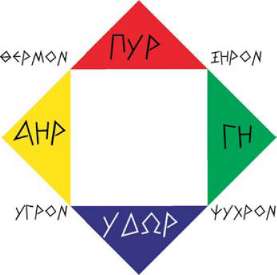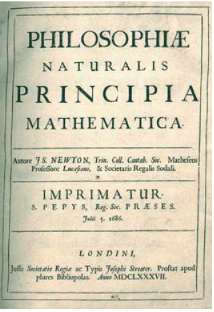Βλέπετε την παλαιά ιστοσελίδα
του τμήματος φυσικής
που ίσχυε έως και 23/3/2024
-
Νέα ιστοσελίδα: https://physics.uoi.gr
How was the Cosmos created? Is there order and simplicity under the surface of the complex and multi-facet Cosmos around us?
These questions were attacked by the Greek philosophers of the 5th and 6th centuries B.C. This period marks the birth of the pre-history of Physics that lasted until the 17th century. The Greek thinkers free of prejudice started to observe the Physical Cosmos and via abstraction were led to the formulation of the above questions in the frame of Rationalism. Irrespective of the completeness of their questions and answers, their basic achievement was that they attempted for the first time in the history of the man-kind to understand the Physical Cosmos based on Logic. Until the Greek philosophers, the explanation of physical phenomena was incorporated in the sphere of the revelation of the truth.
One of the questions that tantalized the ancient philosophers was the composition of matter. The physical philosophers of Ionia and Greece Major (Thales, Anaximander, Anaximenes, Empedocles and others) submitted different proposals regarding the basic elements of matter (water, air, etc). A special position is hold by Heraclitus and Pythagoras who proposed as the main element of the Cosmos the procedure of the struggle of the opposites and the concept of the number, respectively.
An important step is the formulation of the Atomic Theory by Leucippus and Democritus and later on by Epicurus. According to the Atomic Theory matter consists of indivisible and indestructible particles, the atoms. Different combinations of atoms produce the vast variety of the perceivable Cosmos. It took two millennia until the Atomic Hypothesis was experimentally verified, which is considered basically true until now. An important element that was introduced by the Atomists in the thinking of Nature was that the simplicity of Cosmos should be searched at microscopic level.

The Four Elements and Four Qualities of Empedocles
A second topic that occupied the ancients, probably more than the first, was the study of astronomical phenomena. Important authorities, like Aristarchus, Hipparchus, Eratosthenes and others, made big steps forward into the quantitative analysis of phenomena related to the Earth and other heavenly bodies, despite the fact they lacked the most important tool of modern Astronomy, the telescope. In 2nd century B.C. Claudius Ptolemy gathered all the existing observational facts at that time and formulated the homonym geocentric system for the motions of Sun and the planets which dominated the astronomical thinking for more than 1400 years. Another important authority of ancient science was Archimedes whose genius led to the solution of several dozens of mechanics problems, with the laws of Statics and Hydrostatics (Archimedes' principle) being amongst the most outstanding ones.
Aristotle, one of the biggest philosophers of antiquity and the founder of many sciences, studied the problem of the motion of bodies. The conceptual framework of Aristotle's clarifications contained several clearly philosophical concepts like the sedulousness and the concept of physical motion. This was in stark contrast with the conceptual framework of previous physical philosophers and derailed the ancient thinking of Physics from the triptych (observation-abstraction-logic) and led it to erroneous conclusions. The Physics of Aristotle prevailed for two millennia until Galileo toppled it. This marked the end of Physics pre-history era.
The historic period of Physics commences with Nikolaus Copernicus who published his famous heliocentric model on 1543. The existence of two conflicting models, Ptolemy's geocentric and the revolutionary heliocentric led Tycho Brahe to collect astronomical observations of very high accuracy for their time. Copernicus analyzed these observations in great detail and formulated his three famous laws which quantify the heliocentric system.
The dawn of Physics as we know it today took place with Galileo. Galileo was the first to introduce the experimental methodology in the scientific research in a systematic manner. The laws of free fall, projectile motion at an angle, the use of pendulum as a clock, the observation and study of the Sun, Moon and of sky in general with a telescope, the discovery of sunspots and of Jupiter's satellites and many others are the first priceless presents of the new scientific method and its originator to the mankind. The definitive complement to the methodology arsenal of Physics was though supplied by Newton who revived the ancient mathematical art of Archimedes and used it in the formulation and description of the laws of Physics.

The work of Isaac Newton PRINCIPIA
Isaac Newton in his monumental work, Principia, formulated the fundamental laws of motion of terrestrial and heavenly bodies (Newton's laws, law of universal gravitation). With Newton's work Physics became capable of supplying detailed quantitative predictions of the motion of any moving body. The elliptical orbits of Kepler's laws are now the mathematical prediction of Newton's equations of motion. Newton studied also light phenomena. He experimentally proved that white light is indeed a mixture of different colors and he also studied interference phenomena. These studies were published in the work Opticks. However, while Newton's work on the motion and universal gravitation set the foundations of Mechanics, his studies of light did not lead Optics to a commensurate level of maturity. Mechanics was completed with the expansion of its applications to a variety of systems of particles, solids and fluids and reached a high degree of stringency with the reformulation of its laws in the frameworks of the formalisms of Lagrange and Hamilton. Optics made significant progress mainly after the wave nature of light was introduced by Huygens and others. Despite the fact that static electricity and magnetism phenomena were first observed in the antiquity, it was only during the 18th century that their systematic experimental study commenced. The study of electric and magnetic phenomena advanced at an accelerated pace during the 19th century. The experimental work of Faraday and the mathematical equations of Maxwell demonstrated the interrelationships of the two phenomena as well as the electromagnetic nature of light. During the second half of the 19th century Electromagnetism reached levels of completeness and self-consistency commensurate to these of Mechanics. A multitude of seemingly non-connected physical phenomena was finally explained as consequences of the fundamental laws of Electromagnetism (Maxwell's equations). Optics, in particular, was not any more considered as an individual field, but rather a part of the electromagnetic phenomena. During 19th century both Physics and Chemistry revived the forgotten for centuries Atomic Hypothesis. Under the assumption of the existence of microscopic atoms, scientists were able to describe a plethora of complex phenomena of the microcosmos in terms of the motions and interactions between atoms. The science of Thermodynamics which studies the thermal phenomena of matter had reached an advanced level of completeness since the previous century with a wide range of applications. Boltzmann and others, after they had adopted the atomic picture, managed to explain all thermodynamic phenomena by reducing them to kinetic phenomena of a large number of atoms. Thus, Thermodynamics was integrated into Physics as the mechanics of a large number of particles, or Statistical Mechanics. Towards the end of the19th century almost all known phenomena at the time were explained in the frameworks of (Classical) Mechanics, Electromagnetism and Statistical Mechanics. However, this picture turned out to be elusive and did not last for very long.
Towards the end of the 19th century a multitude of new experimental evidence was collected that could not be explained within the standard at the time framework of Mechanics and Electromagnetism. The famous experiment of Michelson and Morley demonstrated that the speed of light does not depend on the motion of the observer and the source, something incompatible with the rules of Mechanics. More generally, it was concluded that an incompatibility exists between Newtonian Mechanics and Electromagnetism, which led Einstein to the formulation of the Special Theory of Relativity. The prevalence of the Special Theory of Relativity demonstrated that Newtonian Mechanics describe approximately the motion of bodies, when their speeds are much smaller than the speed of light which is indeed a universal constant. On the other hand it turned out that Electromagnetism is fully compatible with Relativity. The new element that Relativity introduced into Physics was the rejection of the notion of absolute time. Time in reality is relative, like space, and physical events take place in a mathematically unified space-time continuum. Despite the fact that the relativity of time led to a series of “paradoxes” seemingly at odds with common sense which captured the public attention, Relativistic Mechanics is indeed closely related to Newtonian Mechanics that could be viewed as its extension, or more accurately with the latter viewed as an approximation of the former. Relativistic Mechanics and Electromagnetism form together the Classical Physics.
The discovery of new physical phenomena, like Radioactivity, Röntgen rays and others, prepared the physicists for the unfolding of the internal structure of atoms. Before the end of the 19th century the lightest constituent of atoms, the electron, was experimentally observed. An outstanding role in the discovery of the new laws of the microcosmos was played by experiments of radiation absorption by matter and more specifically the black-body radiation and the photoelectric effect. The first topic led Planck to the theory of quanta which asserts that light is emitted from and absorbed by matter in discrete quantities and not continuously, as the Classical Electromagnetism would have predicted. The photoelectric effect forced physicists to introduce the notion of the photon and to attribute particle properties to light something which is at first sight in contradiction with the wave nature of the electromagnetic radiation of the Classical Electromagnetism. At the same time, Rutherford's experiments finalized the planetary model of the atom with a nucleus and a number of orbiting electrons. The reliability of Rutherford's model was very strongly contested within the frame of Classical Electromagnetism (since every accelerated charge should emit radiation), and led physicists to seek explanations in the direction of the theory of quanta. De Broglie and others, but mainly Bohr, proposed ideas and atomic models with their main characteristic being the co-existence of particle and wave properties of the same object.
Until the beginning of 1920's the formulation of the General Theory of Relativity was practically complete by Einstein, and became widely accepted as the classical description of the gravitational interaction. Until the end of that decade, the new Mechanics of the microcosmos, the Quantum Mechanics, had reached high levels of completeness and was supplying satisfactory answers to almost all the existing at the time experimental data. Quantum Mechanics, and mainly the works of Heisenberg, Schrödinger, Born, and Pauli, represent a radical departure from the established ideas of Classical Physics, which predict that the orbit and speed of particle can be simultaneously known with an unlimited precision. Quantum Mechanics, on the other hand, institutionalized uncertainty as an inherent characteristic of Nature. Its mathematical language is the language of probabilities. Despite the fact that originally Quantum Mechanics found strong opposition, mainly for philosophical reasons, it is currently fully successful and justified from experiment and the numerous technological applications based on quantum phenomena. It is worth mentioning that the unified theory of microscopic electromagnetic phenomena, Quantum Electrodynamics, that was the work of Dirac, Schwinger, Feynman and others, is one of the most precise theories of Physics. However, despite colossal efforts in the following decades, it was not possible to incorporate gravity into this theoretical framework.